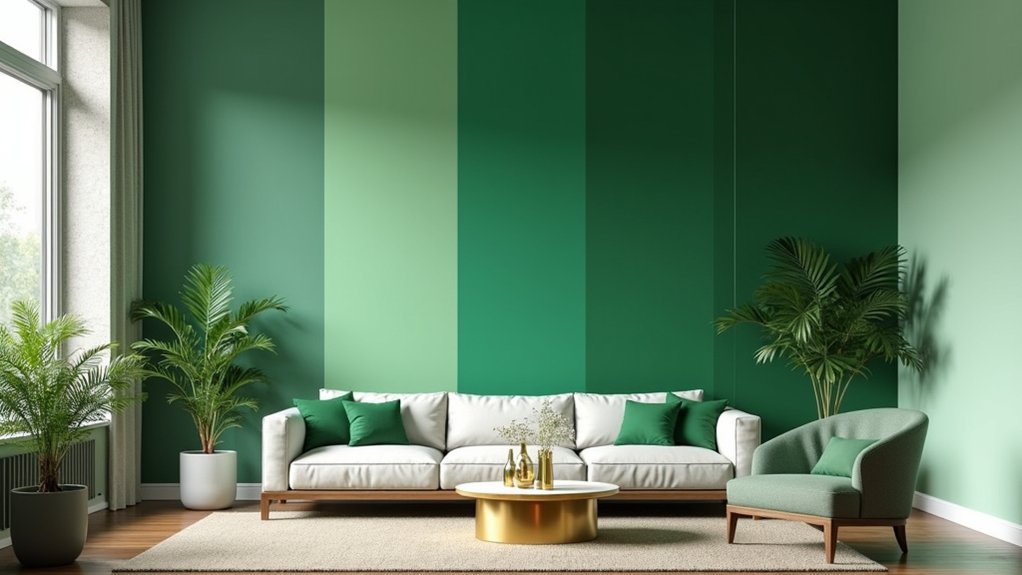
20 Green Living Room Paint Ideas for a Bold and Breezy Look
Green living room paint ideas harness layers of emerald, sage, and aqua for visual depth and breezy energy. Moody olives, muted pistachio, and statement accent walls articulate contemporary trends. Subtle gray undertones lend sophistication, while rich textures—velvet, leather, and grasscloth—elevate tactile intrigue. Pairing green with earthy woods, natural fibers, and indoor botanicals amplifies comfort and freshness. Incorporating mirrored surfaces and sheer treatments maximizes light, ensuring airy harmony. Discover how these curated shades and finishes transform living spaces.
Key Takeaways
- Layer multiple green shades and textures, like olive walls with sage accents, for depth and visual harmony.
- Choose airy aqua or pistachio green for vibrant, breezy ambiance and to amplify natural light.
- Create a bold focal point with a green accent wall or statement green velvet sofa.
- Pair green hues with natural wood, metallic accents, and glass for warmth and luminosity.
- Incorporate lush indoor plants and botanical prints to reinforce the green palette and boost air quality.
Layer Shades of Green
By thoughtfully layering multiple shades of green, a living room can achieve both visual depth and a sophisticated sense of harmony. Interior designers increasingly advocate for a nuanced approach, where one might layer shades of green—such as deep olive walls juxtaposed with mint or sage accents—to cultivate a monochromatic look that is both tranquil and visually engaging. Employing a spectrum of green hues, from verdant emeralds to pale celadons, enables a curated interplay of light and shadow. Textural elements, like a plush light green chair against a saturated green backdrop, introduce tactile contrast and visual intrigue. Precision in selecting base tones and accent variations is essential to maintain cohesion. Adding natural elements like wooden furniture and indoor plants further enhances the room’s organic charm. This technique reflects contemporary color trends, emphasizing versatility and the organic, restorative qualities of green-dominated interiors.
Go For Aqua
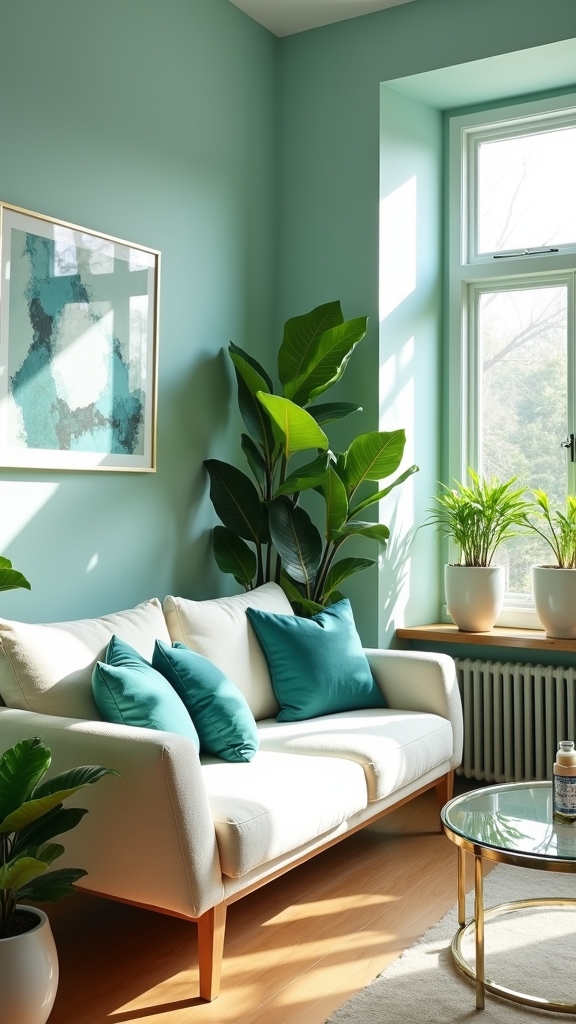
Aqua green infuses living rooms with a luminous quality, amplifying the effects of natural light to create a vibrant yet soothing ambiance.
Its crisp undertones seamlessly align with modern design schemes while offering a revitalizing counterpoint to neutral palettes.
As a trend-forward hue, aqua energizes social spaces, fostering both visual interest and a welcoming atmosphere.
Enhance Natural Lighting
Curiously, how does one maximize the impact of abundant daylight in a living area? The expert answer points to the strategic use of aqua green. This hue amplifies natural lighting, enhancing the spatial perception and liveliness of the room.
Aqua green’s unique undertones interact with sunlight to create a breezy, luminous effect ideal for modern interiors seeking both energy and calm.
Consider these four key strategies:
- Select a satin or eggshell finish to reflect light and maintain a sophisticated aura.
- Coordinate with sheer window treatments that allow daylight to permeate, intensifying the airy ambiance.
- Pair with reflective surfaces—mirrors or glass accents—to further disperse natural lighting.
- Highlight architectural features by using aqua green on focal walls, drawing the eye and celebrating daylight’s impact.
Complement Modern Decor
One of the most effective ways to achieve a contemporary aesthetic in the living room is through the strategic application of aqua green paint. This versatile color serves as a sophisticated backdrop, effortlessly complementing modern decor with its clean, vibrant undertones.
Aqua green adapts seamlessly to a range of interior styles, from minimalistic layouts to more eclectic arrangements, ensuring cohesion while infusing the space with visual interest. Its chameleon-like quality under different lighting conditions introduces dynamic depth, allowing the atmosphere to shift subtly throughout the day.
When paired with neutral furnishings or bold accent pieces, aqua green enhances the setting without dominating it, supporting a fresh and breezy ambiance. This modern hue is both inviting and calming, ideal for contemporary living environments.
Energize Social Spaces
Few hues rival the invigorating effect of aqua green when it comes to energizing social spaces. This green color, with its sophisticated yet playful undertones, is a standout choice for the modern living room, infusing vibrancy and visual depth.
Aqua’s chameleonic quality under different lighting conditions fosters a dynamic ambiance, adapting seamlessly from daylight gatherings to evening soirees. Designers recognize its versatility in both contemporary and coastal settings.
For those seeking to invigorate their living spaces, consider these expert strategies:
- Use aqua as a statement wall to anchor the room’s palette.
- Pair with neutral furnishings to maintain balance and cohesion.
- Incorporate metallic or glass accents for a trend-forward, luminous effect.
- Enhance natural light to maximize aqua’s energizing potential in social environments.
Opt for Soothing Sage
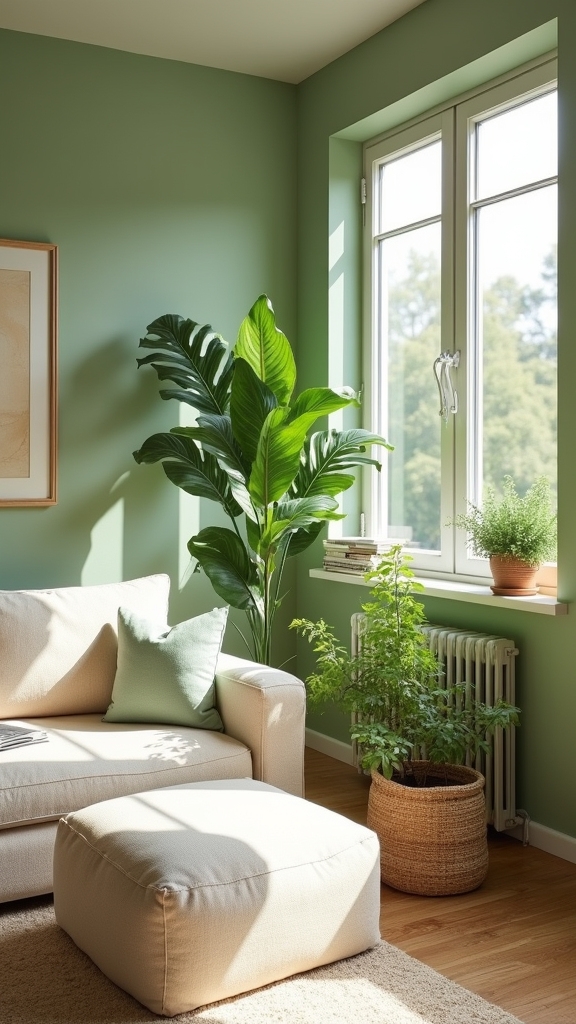
Sage green emerges as a trend-forward choice for living rooms, blending understated vibrancy with versatile appeal across decor styles. This sophisticated hue is celebrated for its calming effect, making it a versatile choice that effortlessly anchors both contemporary and traditional interiors. Sage green paint’s muted undertones amplify spatial tranquility while accommodating bold design statements. Its velvety depth radiates confidence, establishing a serene yet inviting atmosphere ideal for relaxation and social gatherings. When paired with peach or tan, sage green enhances warmth and coziness, ensuring the space feels balanced and intentional. Incorporating warm greens like forest green enhances coziness and connects the space to nature, creating a tranquil haven. The following table illustrates key attributes of sage green in living room design:
| Attribute | Visual Effect | Design Benefit |
|---|---|---|
| Calming Effect | Understated Glow | Enhances Relaxation |
| Versatile Base | Pairs with Tones | Adapts to Any Style |
| Depth & Warmth | Inviting Ambience | Amplifies Sophistication |
Add a Tinge of Gray
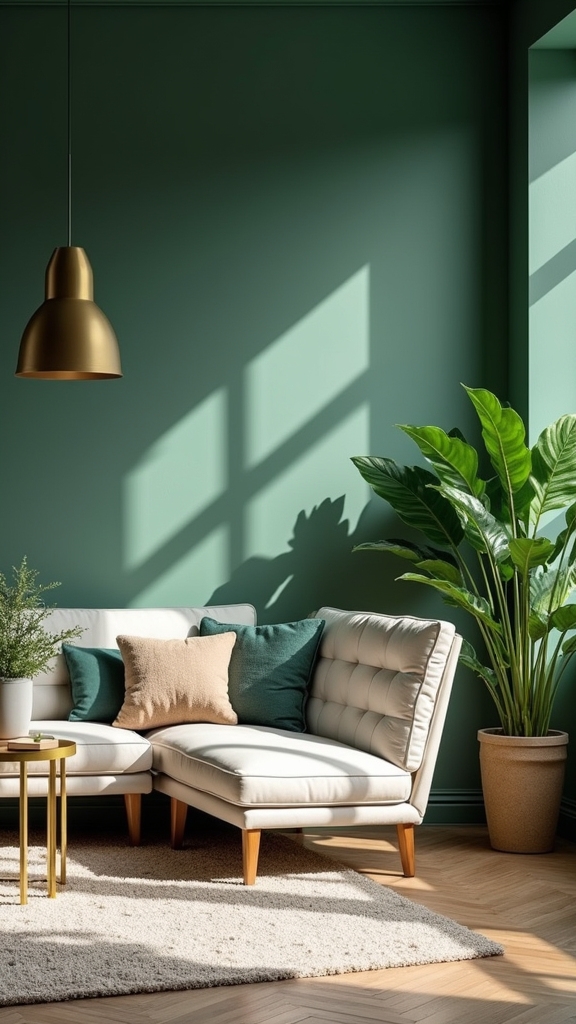
Infusing green with subtle gray undertones introduces a nuanced timelessness that resonates with both contemporary and classic sensibilities.
This sophisticated palette seamlessly complements traditional décor, enhancing architectural details without dominating the space.
The result is a serene, uplifted ambiance—an increasingly popular choice among designers seeking both tranquility and visual depth in modern living rooms.
Achieving Subtle Timelessness
A harmonious fusion of muted green tones with a subtle gray undertone delivers a sophisticated, enduring foundation for living room design.
This approach enhances the ambiance with a subtle aesthetic, balancing trend-forward color palettes and timeless look. Experts note that this nuanced color blend offers remarkable versatility, easily integrating diverse textures and natural materials for visual depth.
The muted green shade, softened by gray, avoids overt vibrancy, maintaining elegance over years of evolving interior trends.
- Versatility: Muted green with gray undertones pairs seamlessly with off-white, tan, and natural textures, adapting to varied decor schemes.
- Calming Aura: The color’s tranquil nature fosters a serene, restful environment.
- Visual Warmth: Gray-infused greens serve as an inviting backdrop for layered materials.
- Timeless Appeal: This palette guarantees enduring style beyond fleeting trends.
Complementing Classic Decor
Emerald velvet sofas and dark wood sideboards find refined harmony against walls painted in green with a subtle gray infusion.
This muted shade introduces a sophisticated undertone, seamlessly integrating with classic decor while highlighting the intrinsic elegance of wooden furniture.
The gentle gray component within the green creates a composed backdrop, allowing ornate moldings, vintage accents, and time-honored design elements to stand out without visual competition.
Interior designers favor this approach for its ability to infuse traditional spaces with a modern sensibility, all while preserving a timeless aesthetic.
The gray-green palette’s versatility guarantees that both bold and understated accessories can be layered effortlessly, supporting trend-forward yet respectful interpretations of classic decor.
It is a nuanced solution for those seeking enduring, understated style.
Elevating Tranquil Atmosphere
Many contemporary designers recognize that introducing a tinge of gray to green paint masterfully tempers its vibrancy, resulting in a refined palette that radiates tranquility.
This nuanced approach to color selection highlights the calming qualities inherent in muted green shades, perfectly suited for cultivating a tranquil environment.
The interplay between green and gray offers visual softness while maintaining a fresh, modern sensibility. Experts recommend this technique to harmonize with diverse design elements and guarantee adaptability in various interiors.
- Muted green shades with gray undertones evoke understated sophistication, enhancing both classic and modern spaces.
- The calming qualities of this combination establish a serene, inviting atmosphere ideal for relaxation.
- A tranquil environment is achieved by balancing boldness with subtlety, preventing visual overwhelm.
- Versatile compatibility enables effortless pairing with neutral, earthy furnishings and diverse accessories.
Use a Medium Tone Shade
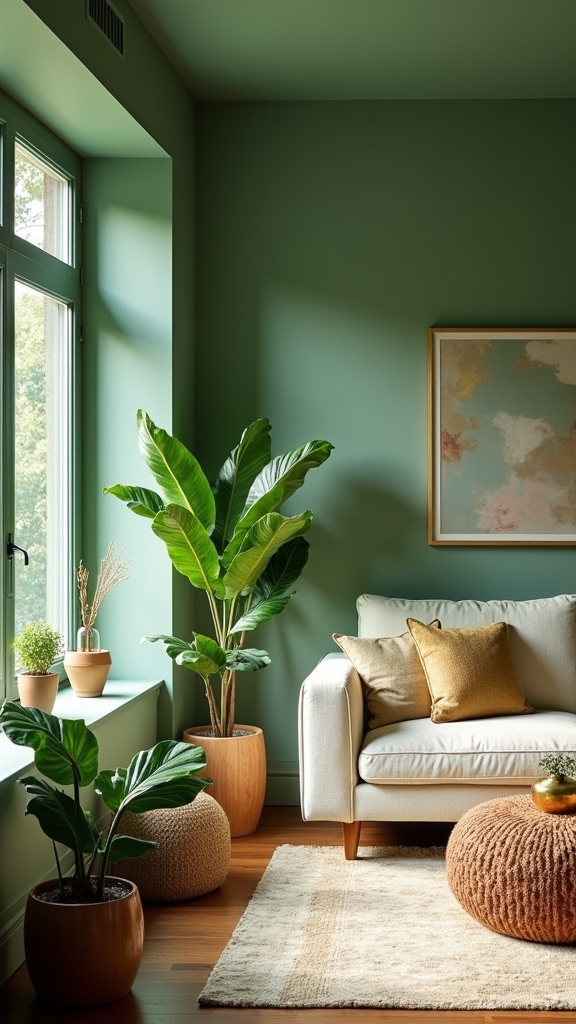
Mid-tone greens command attention in contemporary interiors, offering a harmonious blend of vibrancy and subtlety that enhances the living room’s ambiance.
These medium tone greens inject personality into the space, cultivating an inviting atmosphere that feels both grounded and dynamic. Earthy hues within this spectrum resonate with current design trends, supporting compatibility with both bold accent pieces and minimalist, neutral furnishings.
Medium tone greens bring personality and warmth, pairing effortlessly with bold accents or minimalist décor for a truly inviting living room.
The nuanced character of medium greens effortlessly bridges the gap between modern and traditional aesthetics, making them a versatile choice for designers seeking adaptability without visual overload.
Additionally, medium tone greens evoke the sensation of nature indoors, capturing the lush essence of the outdoors and imbuing the room with a revitalizing, rejuvenating character.
This approach defines a sophisticated yet approachable canvas for curated living room design.
Accent With Black
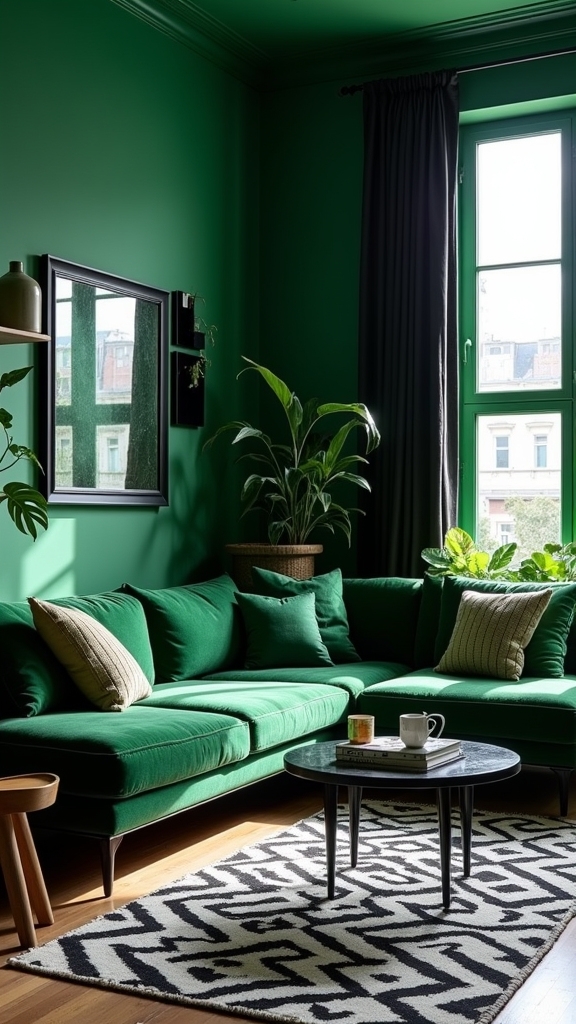
A select use of black accents introduces a sophisticated edge to green living room palettes, anchoring the space with visual weight while enhancing the depth of the green hue.
The interplay between deep green walls and thoughtfully placed black accents—such as minimalist lighting, sleek furniture, or curated art frames—delivers a modern twist that feels intentional and striking.
This design strategy is especially effective in compact living rooms, where bold contrasts add drama without overwhelming the area.
For a curated and trend-forward aesthetic, consider these expert applications:
- Pair deep green paint with matte black shelving or side tables for heightened dimension.
- Introduce graphic black-and-white textiles to punctuate the color scheme.
- Use black-framed mirrors to reflect light and create spatial depth.
- Opt for sculptural black lighting fixtures for a contemporary finish.
Natural sunlight enhances the richness of black tones and spaciousness, making it an ideal complement to green hues in a living room setting.
Go Dark
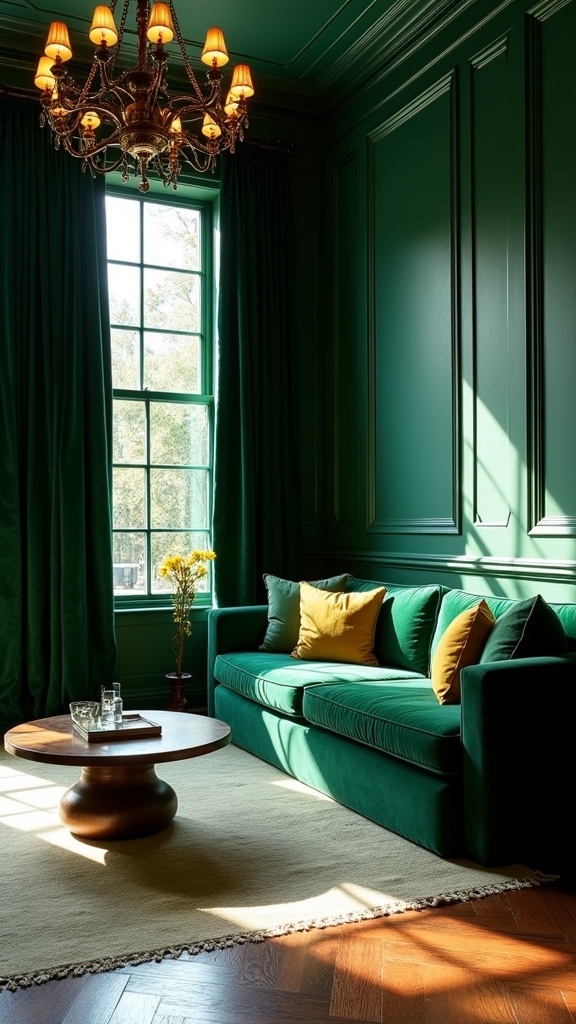
For those seeking moody midcentury modern vibes, dark green paint delivers a saturated backdrop with near-black intensity, enhancing visual drama. When paired with natural wood tones, this palette raises organic warmth and emphasizes textural contrast. The result is a living room that channels current design trends while maintaining a sense of refined comfort. Incorporating statement art pieces can further elevate the aesthetic by introducing stylish focal points and enhancing the overall ambiance.
Moody Midcentury Modern Vibes
Saturation and depth define the allure of moody midcentury modern living rooms, where dark green walls anchor the space with dramatic sophistication. This palette invokes a sense of richness and depth, channeling the iconic elegance of midcentury modern interiors.
Dark green acts as both a grounding backdrop and a statement feature, elevating the architectural geometry and clean lines characteristic of the era. Expert designers leverage this shade to create a welcoming cocoon that feels timeless yet current.
- Dark green walls: Deliver instant visual weight, fostering intimacy and intrigue.
- Midcentury modern furnishings: Enhance the retro undertones and reinforce the room’s structural harmony.
- Lighter accents: Whites or pastels contrast and soften, preventing visual heaviness.
- Metallic elements: Gold or brass infuse subtle luxury, accentuating the richness and depth.
Pair With Natural Wood
Rich forest and emerald green walls establish a striking foundation when juxtaposed with natural wood elements, a pairing that resonates with current interior design sensibilities.
The interplay between a dark green accent and natural wood introduces depth and dimension, creating a visually immersive yet inviting space. Light or medium-toned woods—such as oak or maple—offer a refined contrast, while darker species like walnut or mahogany foster a cohesive, harmonious look.
Integrating dark wood beams or furniture amplifies the organic, nature-inspired narrative, further enhanced by the rich undertones of green. To prevent the palette from feeling overpowering, designers suggest incorporating light textiles and accessories, maintaining balance and a sense of airiness.
This approach guarantees a bold yet comfortable living room aesthetic.
Try a Pastel Hue
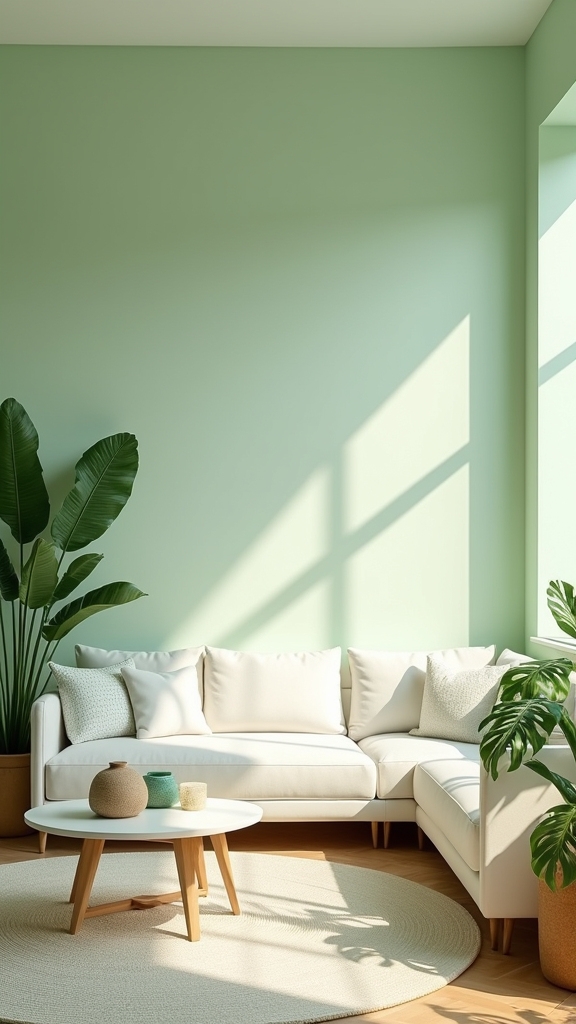
When integrated into living room design, pastel green functions as a subtle yet dynamic neutral, adapting seamlessly to shifting natural light and diverse décor aesthetics. Its versatility as a neutral color enables effortless coordination with a spectrum of furnishings and finishes, while imparting a gentle, breezy ambiance.
Pastel green’s nuanced presence brings a serene environment to the forefront, balancing color expression with visual tranquility. Design experts highlight its ability to anchor modern, minimalist, or even classic interiors without overpowering the space.
Pastel green creates a tranquil atmosphere, offering subtle color while grounding interiors in calm sophistication without dominating the space.
- Monochromatic Harmony: Layering multiple pastel green shades enhances depth while maintaining unity.
- Complementary Pairings: Pastel green integrates beautifully with tan, beige, or other pastels for a cohesive, calming palette.
- Light Amplification: Reflects daylight, maximizing perceived space and airiness.
- Mood Elevation: Promotes relaxation and rejuvenation, perfect for communal living zones.
Mix In Jewel Tones
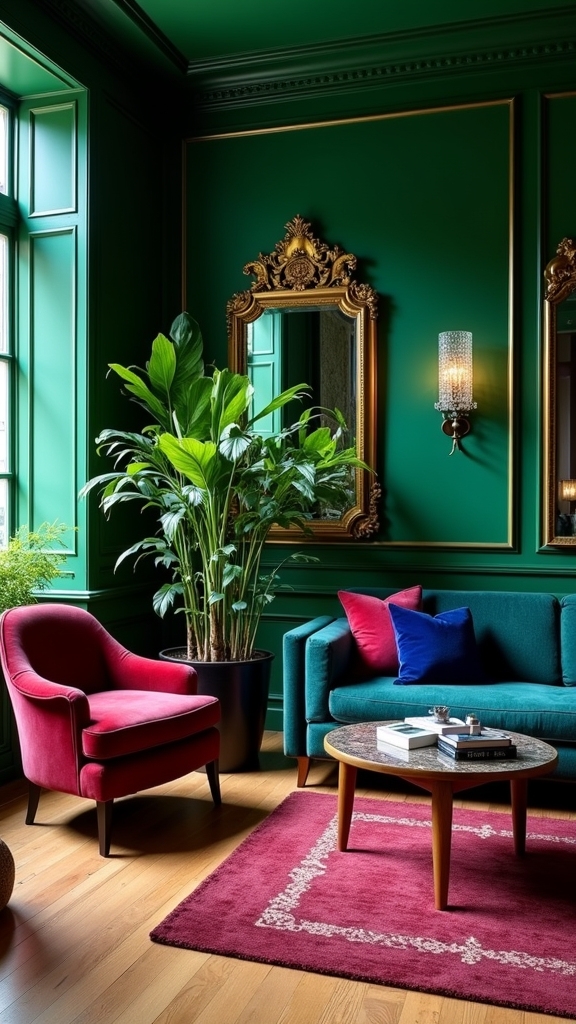
Although green serves as a foundational hue in living room palettes, integrating jewel tones introduces a dramatic layer of visual complexity and richness. When paired with green, accent colors such as deep sapphire blue, rich amethyst purple, and bold ruby red deliver both vibrancy and sophistication, enhancing the living room’s overall aesthetic. This dynamic interplay is especially effective in accent pieces—throw pillows, artwork, or decorative accessories—providing an immediate, trend-forward refresh. For best results and visual harmony, limiting selections to two or three jewel tones prevents the space from feeling chaotic. This curated approach balances opulence with restraint, allowing green to remain prominent while jewel tones create depth and intrigue. Incorporating textured wallpaper can further enhance the sophistication of the room by adding visual interest and complementing the jewel tones.
| Jewel Tone | Effect with Green |
|---|---|
| Sapphire Blue | Cool, invigorating depth |
| Amethyst Purple | Regal, artistic flair |
| Ruby Red | Bold, energizing accent |
| Emerald (with Green) | Layered sophistication |
Embrace Dark Olive
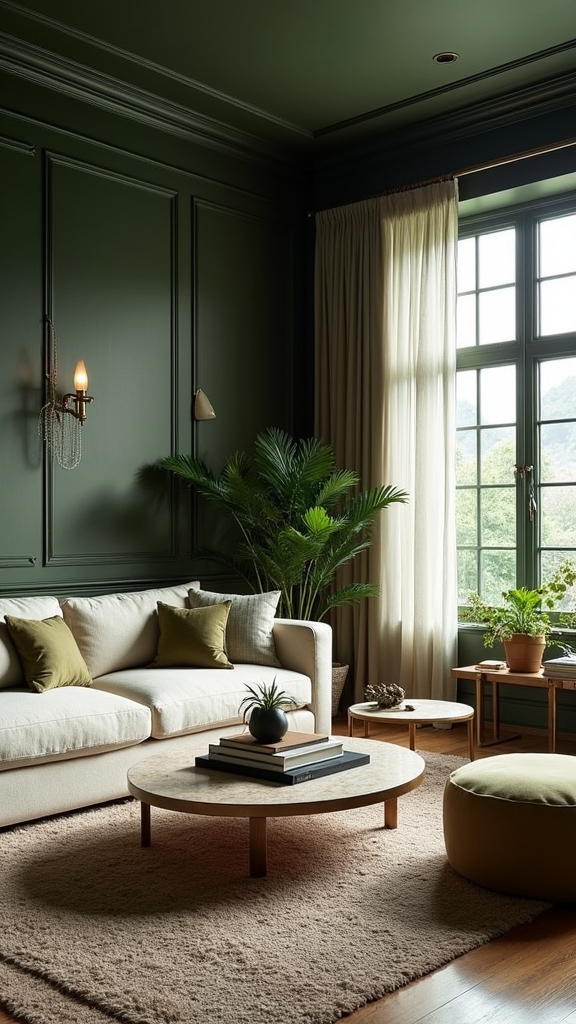
A measured application of dark olive paint instantly infuses a living room with moody sophistication, establishing a dramatic backdrop that retains warmth and approachability.
This nuanced green, trending among design-forward interiors, offers versatility across a range of aesthetics—from modern minimalism to rustic retreat. Dark olive’s deep, saturated tone enhances spatial depth and invites layered styling with bold, earthy accents.
For a curated and visually balanced look, consider these expert recommendations:
- Pair dark olive walls with natural wood furnishings to amplify organic undertones and reinforce a grounded, harmonious atmosphere.
- Layer in neutral textiles and metallic fixtures to counterbalance the moody feel without diminishing the paint’s impact.
- Integrate earthy accents such as terracotta pots or woven baskets for authentic texture.
- Opt for lighter upholstery to maintain luminosity and avoid visual heaviness.
Incorporating wooden furniture like farmhouse tables can further elevate the rustic charm and timeless appeal in your dark olive-themed living room.
Mix in a Botanical Print
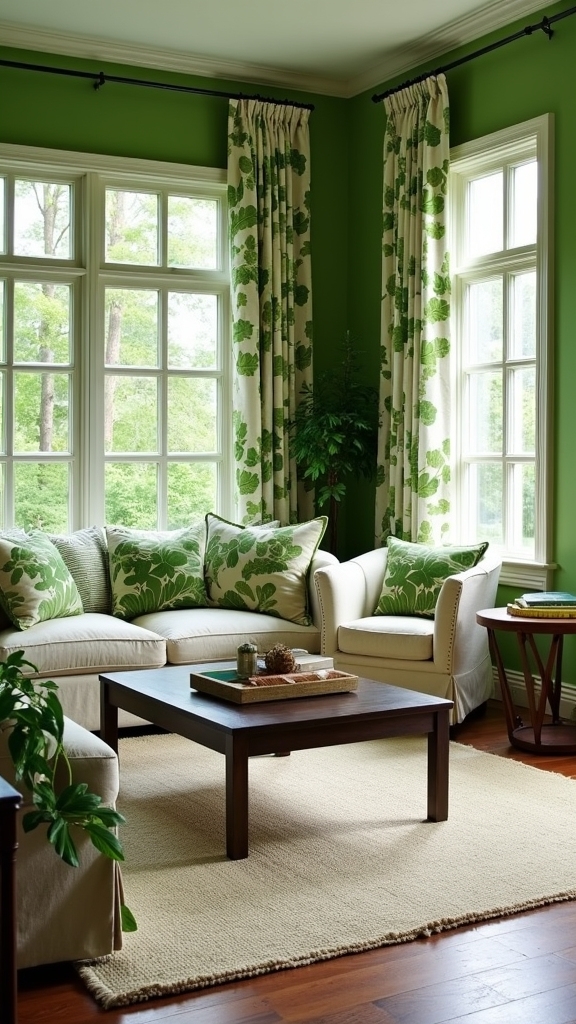
By integrating botanical prints into the living room, designers can reinforce the green palette with layers of visual intrigue and organic vibrancy. Botanical prints—whether expressed through wallpaper, textiles, or curated art—inject a sophisticated nod to nature while elevating visual interest. Green velvet sofas become standout features when juxtaposed with lush, leafy patterns, creating a focal point that feels both curated and dynamic. This synergy between green velvet and botanical motifs fosters a timeless yet contemporary ambiance, adaptable to both modern and eclectic interiors. Strategic placement of botanical prints, such as on cushions or as artwork, allows for effortless seasonal updates without overwhelming the space. Incorporating earthy grey as a neutral backdrop enhances the appeal of green velvet sofas and botanical prints, providing balance and sophistication. The following table highlights possible pairings for maximum impact:
| Botanical Prints | Green Velvet Feature | Visual Interest Element |
|---|---|---|
| Wallpaper | Sofa | Cushions |
| Curtains | Armchair | Throw blanket |
| Artwork | Ottoman | Area rug |
| Cushions | Bench | Accent wall |
Pair Green and Brown
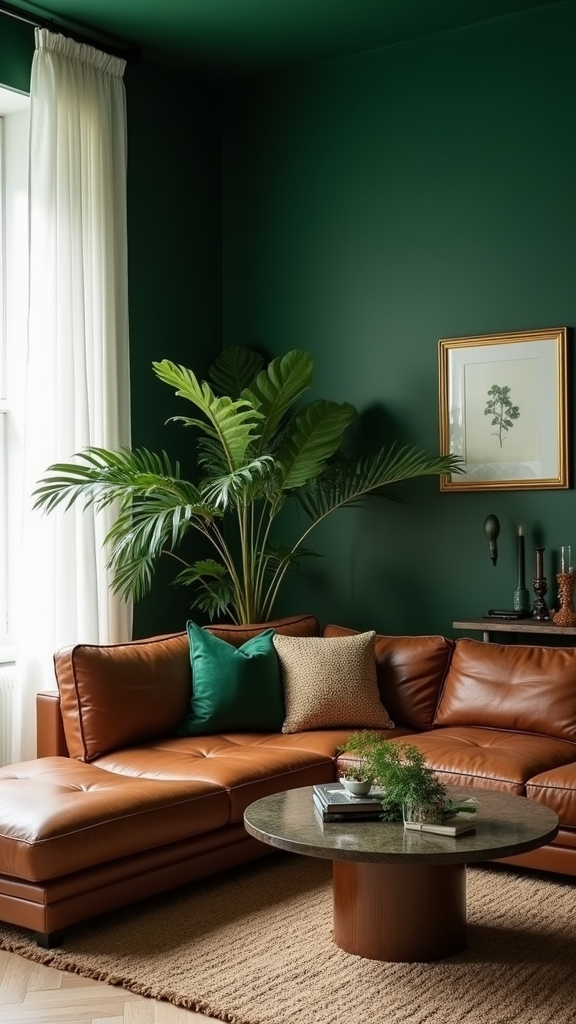
Pairing green and brown in the living room establishes an earthy color harmony that is both on-trend and timeless.
Rich wooden accents, such as dark walnut flooring or mid-century modern furnishings, amplify the visual depth against green-painted walls.
Achieving balance between deep and light tones within this palette allows for a cohesive yet dynamic aesthetic adaptable to multiple interior styles.
Embrace Earthy Color Harmony
When integrated thoughtfully, green and brown establish a sophisticated, earth-inspired palette that channels tranquility and a seamless connection to the outdoors.
This earthy color harmony is increasingly favored in contemporary living rooms for its ability to evoke calm and a natural vibe. Expertly chosen green walls—ranging from sage to olive—serve as a serene backdrop, while brown infuses warmth and grounding.
For an enhanced look:
- Select muted greens paired with deep, chocolate browns for a refined, cohesive ambiance.
- Integrate organic materials like jute rugs and woven textiles to amplify the earthy color harmony.
- Employ botanical decor or houseplants to reinforce the natural vibe and enliven the space.
- Balance the palette with neutral accents, ensuring the green and brown tones remain the visual focal point.
Use Rich Wooden Accents
Introduce depth and warmth to a green living room by integrating rich wooden accents, a design strategy favored in upscale interiors for its balance of cool and earthy tones.
The interplay between green paint colors—such as forest green or sage—and dark wood furnishings like mahogany or walnut instantly boosts the room’s sophistication.
Natural wood elements, including exposed ceiling beams or hardwood flooring, reinforce a seamless connection between indoor and outdoor aesthetics while providing tactile contrast.
This pairing not only enhances the visual interest of textured surfaces but also fosters a cozy and relaxing environment.
The green and brown color combination is increasingly sought after in contemporary design for its ability to ground a space, making the living room both tranquil and inviting while maintaining a modern sensibility.
Balance Deep and Light
Achieve a sophisticated interplay of contrast and cohesion by juxtaposing deep green walls with light brown furnishings—a method increasingly favored in contemporary design circles.
This nuanced approach leverages the visual depth of deep green while introducing the warmth and subtlety of light brown, resulting in a space that feels both anchored and inviting.
Through calculated balance, this combination bridges boldness with softness, reflecting an organic yet refined aesthetic that aligns with biophilic design trends.
- Contrast Effect: Deep green walls create a dramatic canvas that accentuates the lighter, earthy tones of brown furniture.
- Textural Interest: Incorporate light brown elements in natural materials like rattan, leather, or reclaimed wood for added depth.
- Organic Connection: Balance green and brown to evoke tranquility and a seamless indoor-outdoor shift.
- Cohesive Warmth: Layering these tones guarantees a harmonious, welcoming ambiance.
Add Pistachio Accents
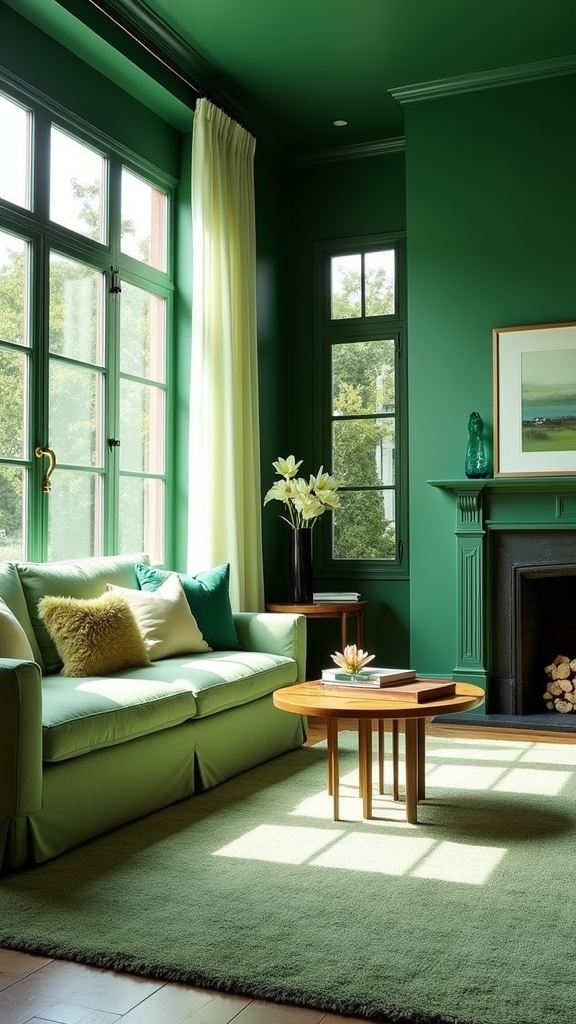
A touch of pistachio green infuses the living room with a lively, contemporary edge, instantly elevating the space’s atmosphere. Design experts recognize pistachio green as a modern accent that harmonizes effortlessly with both neutral and bold palettes, enhancing versatility across decor styles. Strategic placement of pistachio accents—such as cushions, vases, or art—permits homeowners to refresh their living room without a full redesign. This hue’s subtle warmth promotes tranquility, making it ideal for relaxation zones or social settings. Pistachio green pairs exceptionally well with organic textures like wood or rattan, amplifying the connection to nature and reinforcing an inviting, breezy aesthetic. Incorporating natural elements and greenery alongside pistachio accents can further enhance the space’s connection to nature, creating a vibrant and refreshing environment. The trend-forward appeal of pistachio green guarantees that living room updates remain both stylish and adaptable for evolving tastes.
Play With Texture
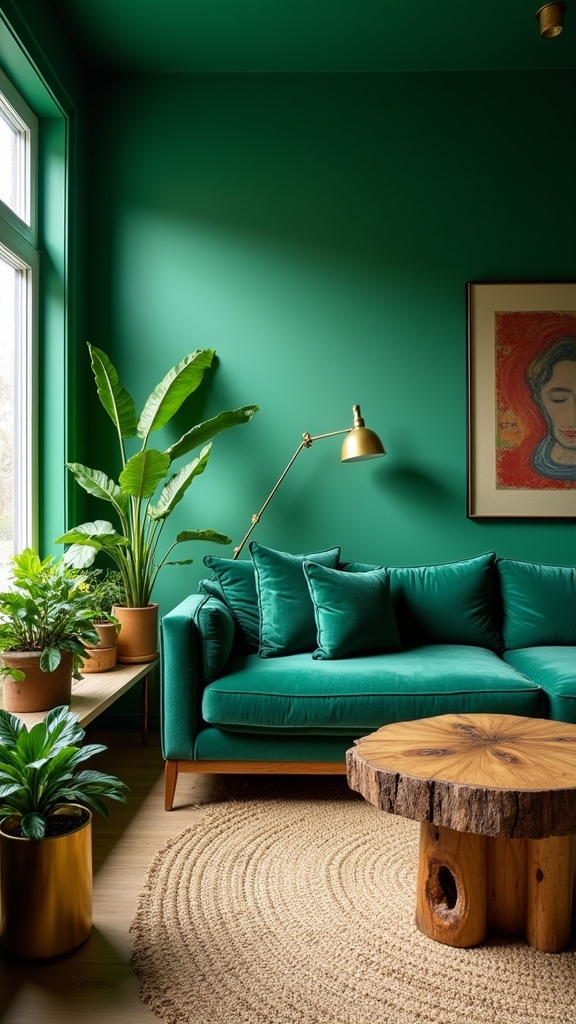
When curating a green living room, thoughtful manipulation of texture transforms painted surfaces from flat to multidimensional, enriching the space’s aesthetic narrative.
Employing a sophisticated approach to layering tactile elements can profoundly influence the atmosphere, making green hues appear more vibrant and immersive. Current interior trends emphasize juxtaposing soft and rugged surfaces to create a harmonious yet visually dynamic environment.
Consider these expert strategies:
- Plush Velvets & Woven Throws: Introduce velvet cushions or woven blankets in deep green tones for tactile richness.
- Textured Wall Treatments: Apply grasscloth wallpaper or a stucco finish to accentuate the depth of green paint.
- Material Layering: Pair green rugs with natural wood tables to enhance warmth and color impact.
- Contrasting Accents: Mix ceramic vases with raw wood furniture to maintain visual intrigue.
- Mix Materials Wisely: Balance textures like leather and velvet for visual appeal and comfort, ensuring material durability and a cohesive aesthetic.
Try a Soft Pistachio Hue
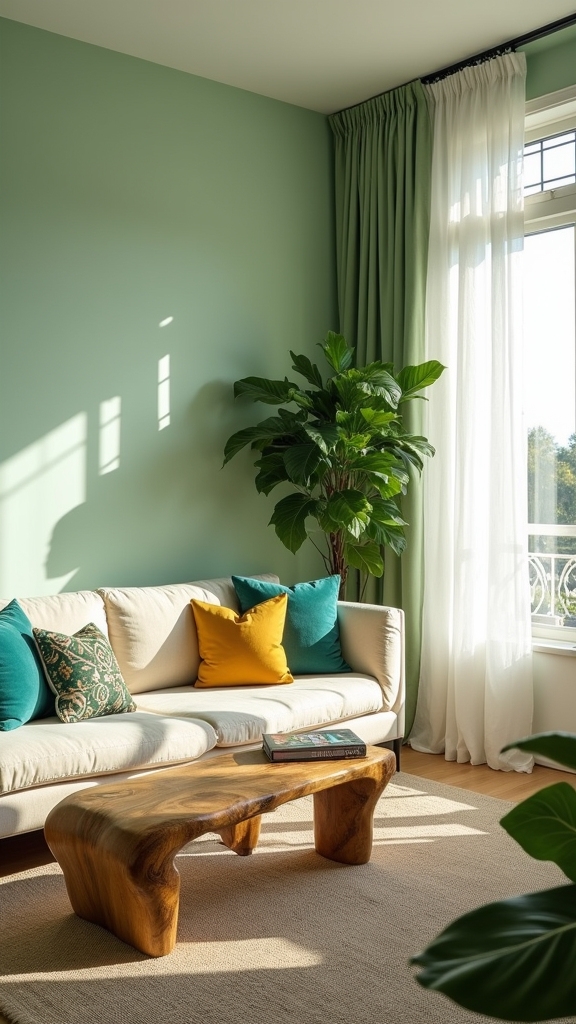
Soft pistachio green, with its subtly invigorating undertones, emerges as a leading choice for those seeking to infuse their living rooms with an airy freshness that aligns with current color trends.
This soft pistachio hue instantly brightens interiors, delivering a breezy and inviting ambiance that appeals to both modern and traditional sensibilities. Expertly paired with light wood furniture, the pastel shade maximizes the sense of space and luminosity, while crisp white accents further enhance the room’s openness.
The understated vibrancy of pistachio green energizes the environment without overwhelming the senses, fostering a serene yet dynamic setting. Incorporating indoor plants alongside pistachio walls intensifies the natural, organic aesthetic, seamlessly connecting the indoors with the outdoors and solidifying the room’s contemporary, eco-conscious appeal.
Accent With Warm Tones
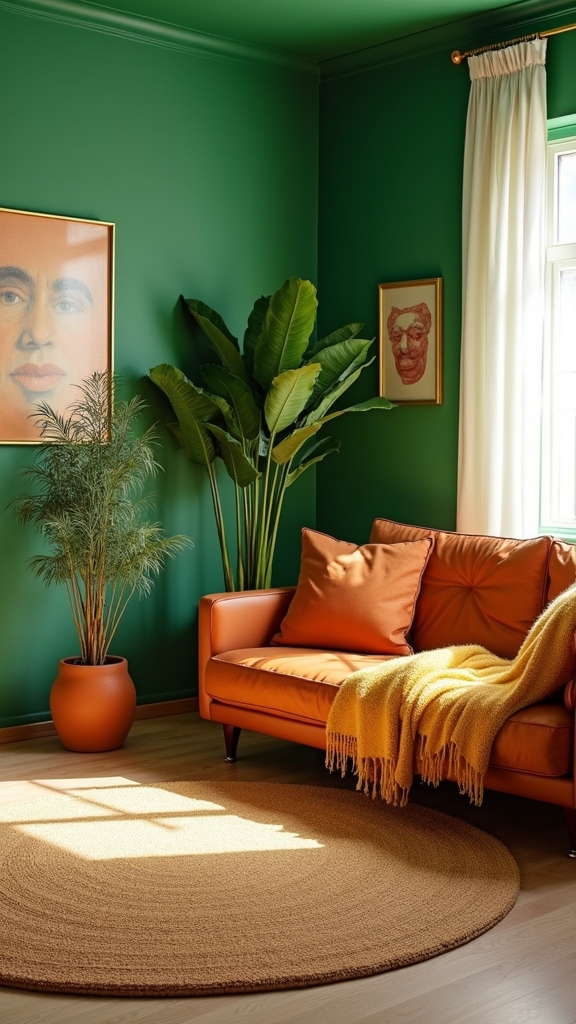
Though green serves as a versatile foundation in living room design, the strategic incorporation of warm tones—such as burnt orange, gold, and peach—elevates the palette with dynamic contrast and visual depth.
These hues, when paired with green accents, not only enrich the chromatic scheme but also cultivate a cozy atmosphere that feels both sophisticated and inviting.
To achieve a harmonious balance, experts recommend layering warm tones through accessories and lighting, ensuring the green base remains visually prominent.
Consider the following techniques for integrating warm tones:
- Textile Integration: Select throw pillows and rugs in warm hues to accentuate green accents.
- Wood Elements: Opt for warm wood furniture to establish an inviting, grounded ambiance.
- Artwork Selection: Curate art and decor featuring gold or peach undertones.
- Ambient Lighting: Employ yellow or amber bulbs to enhance green’s richness.
By incorporating neutral tones like whites and creams, you can accentuate the green walls while maintaining a sophisticated and calming ambiance.
Try a Green Accent Wall
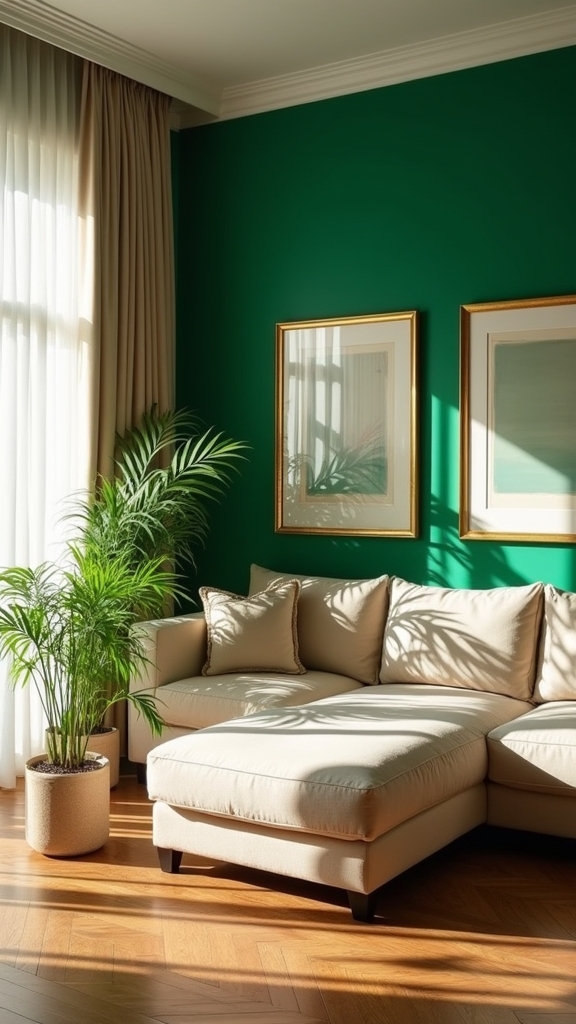
A green accent wall introduces a dynamic focal point, with shade selection—such as emerald or mint—dictating the mood and visual impact.
Expert coordination with neutral textiles and curated decor guarantees cohesion, while maximizing available natural light accentuates the depth and vibrancy of the chosen green.
This approach aligns with contemporary design trends, blending boldness and biophilic appeal for a sophisticated living space.
Choosing the Perfect Shade
How does one achieve a striking yet balanced aesthetic in the living room? Selecting the ideal shades of green for a green accent wall is pivotal in defining the room’s character.
Deep hues like emerald or verdigris green impart opulence and drama, serving as a sophisticated focal point when paired with complementary decor. Conversely, lighter tones such as mint or sage maximize luminosity and evoke a breezy, open feel—especially effective in expansive spaces.
To guarantee peak impact, one should consider spatial dynamics and desired ambiance.
- Evaluate room size: darker shades create intimacy; lighter greens expand visual space.
- Assess natural lighting: lighter greens amplify brightness; dark greens add depth.
- Select shades of green aligned with personal style and current design trends.
- Integrate complementary decor for cohesive visual synergy.
Coordinating Decor Elements
When executed with thoughtful intention, a green accent wall instantly anchors the living room, offering a vivid focal point that enhances the entire space.
Expert designers recommend opting for muted or pastel green shades on the accent wall to establish a calming backdrop, which simultaneously allows for the integration of bolder decor elements.
The strategic use of complementary colors—such as crisp white or natural light wood tones—promotes visual equilibrium and prevents the green accent wall from dominating the aesthetic.
Incorporating indoor plants adjacent to the accent wall further reinforces a biophilic ambiance, accentuating the room’s connection to nature.
Layering various green shades across textiles, furniture, and accessories introduces depth and textural interest, aligning with contemporary trends in holistic, nature-inspired interiors.
Maximizing Natural Light
Building on the harmony achieved through coordinated decor, maximizing natural light becomes a strategic consideration in green living room design.
Utilizing a green accent wall not only establishes a visual focal point but also enhances spatial perception by amplifying available light. Experts suggest that lighter shades of green paired with light-colored furnishings can greatly increase the room’s luminosity, creating a breezy, open vibe aligned with contemporary trends.
For an improved aesthetic, consider these professional recommendations:
- Opt for a glossy green accent wall to reflect natural light and add visual depth.
- Position large windows or mirrors opposite the accent wall to intensify light dispersion.
- Select light-colored furnishings to further brighten the space and enhance openness.
- Embrace minimalistic decor to maintain an airy, uncluttered appearance.
Try Green Color-Drenching
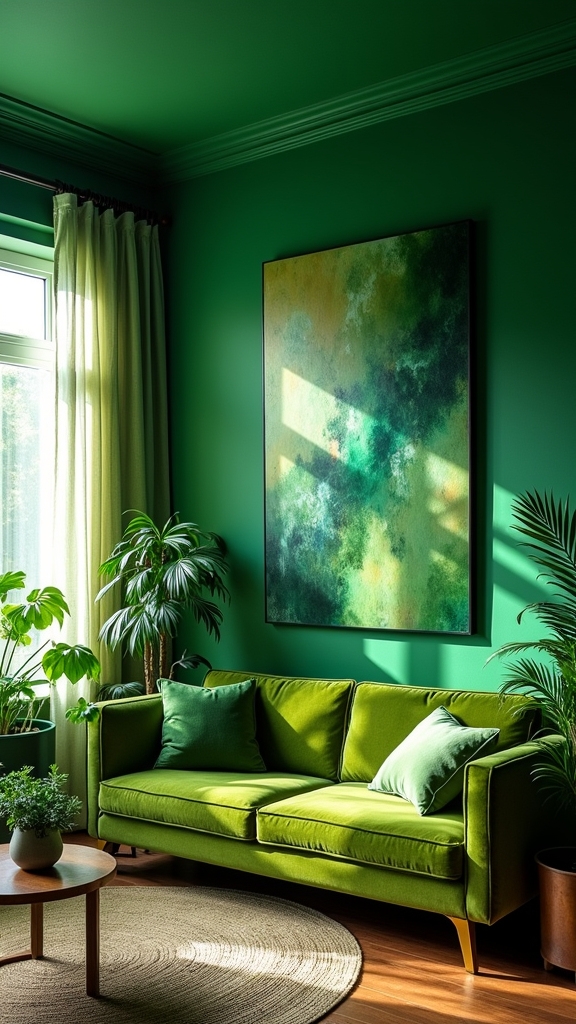
A lush palette of green, applied through the technique of color-drenching, transforms a living room into a cohesive sanctuary reminiscent of nature’s tranquility.
Green color-drenching leverages both light and dark greens to construct visual depth and dynamic layering within a space. Lighter greens—think misty sage or soft mint—imbue the environment with a breezy, airy quality, while richer shades such as forest or olive inject drama and sophistication.
Expertly layering these hues across walls, trim, and furnishings, the scheme creates a seamless, immersive effect that’s both trend-forward and grounded in biophilic design principles.
The result is an enveloping sense of tranquility and calm, where every surface contributes to a unified, organic aesthetic that resonates with contemporary interior trends.
Pair With Greenery
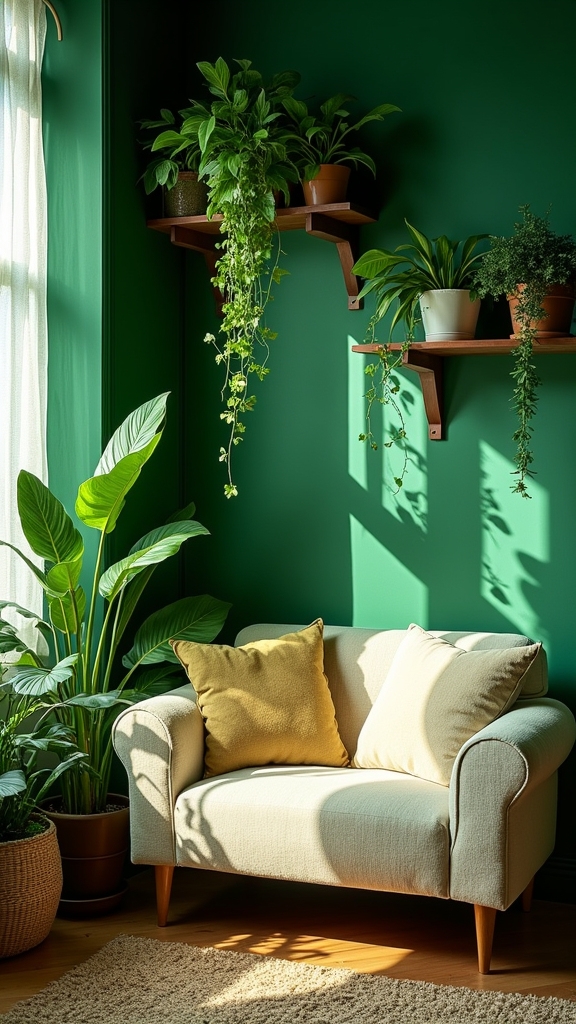
Verdant synergy emerges as green walls and decor are paired with live plants, amplifying the organic ambiance of the living room.
The convergence of green paint and indoor greenery creates a biophilic environment, fostering a sense of tranquility and visual depth. Leafy palms, sculptural succulents, and cascading vines not only complement the spectrum of green hues but also invigorate the space with their dynamic forms.
This approach aligns with contemporary interior trends that prioritize wellness and sustainability.
- Depth and Layering: Utilize varied green paint shades to enhance the dimensionality of plant displays.
- Focal Points: Employ statement greenery, such as oversized monstera or fiddle leaf figs, to draw the eye to architectural details.
- Air Quality: Integrate air-purifying plants to improve well-being.
- Seamless Connection: Blend green decor with live plants for cohesive, nature-inspired design.
Keep It Understated
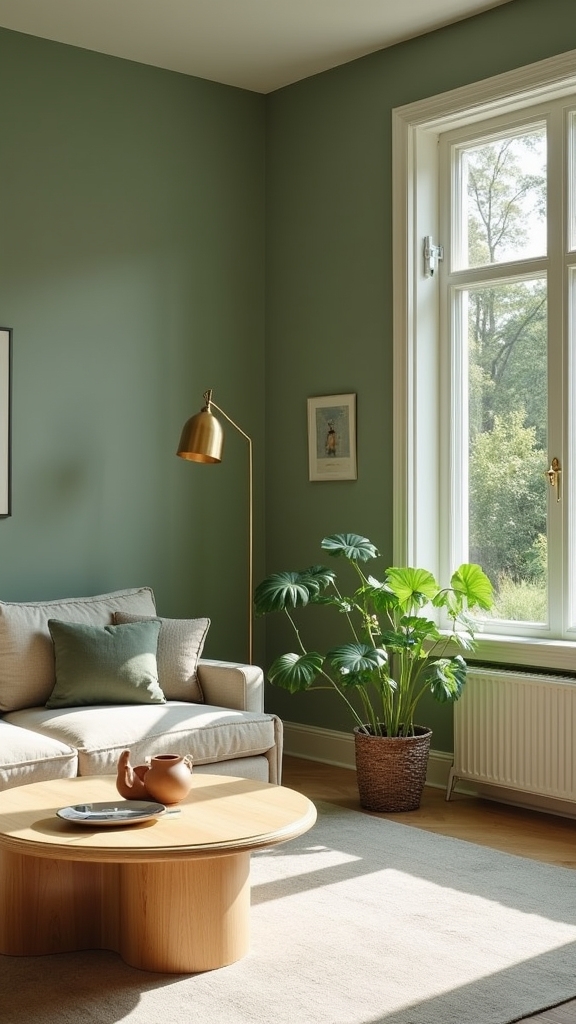
While lush greenery amplifies the natural energy of a living room, an understated green palette delivers refined sophistication.
Muted green paint, with its subtle undertones, offers a timeless and classic aesthetic favored by design professionals seeking elegance without visual overload. This muted shade fosters a calming environment, making it an ideal backdrop for relaxation and tranquility.
Combining muted green walls with off-white or tan accents establishes an understated aesthetic that remains adaptable to evolving decor trends.
Layering various shades of green—such as sage, olive, or moss—introduces depth and visual intrigue, yet sustains a cohesive palette. The restrained use of color in this approach not only enables flexibility in furnishings and accessories but also supports a serene ambiance, aligning with contemporary preferences for restful, minimal spaces.
Frequently Asked Questions
What Is the Most Calming Green Color?
The most calming green color, according to color theory and wellness trends, is sage green. This tranquil green shade anchors soothing green palettes, while muted olive and pastel mint also exemplify calming green hues favored in serene, on-trend interiors.
What Shade of Green Makes a Room Look Bigger?
When considering room perception, experts highlight light green hues for their ability to visually expand interiors. Color psychology suggests these tones reflect natural light, amplifying spatial depth. This trend-driven approach guarantees a larger, airier environment through strategic color selection.
What Color Goes With Green Walls in a Living Room?
When considering what color goes with green walls in a living room, designers recommend integrating green accent colors, curated green furniture choices, and strategically placed green wall art alongside soft pinks, warm neutrals, and brass elements for contemporary visual harmony.
What Is the Most Attractive Green Color?
Determining the most attractive green color depends on context and intent. Forest green psychology suggests sophistication and tranquility, mint green trends highlight freshness and modernity, while olive green pairings offer versatile, earthy harmonies, reflecting evolving interior design preferences.
Conclusion
In conclusion, green remains a dynamic force in living room design, offering both bold statements and serene retreats. Whether through tonal layering, muted sages, or on-trend color-drenching, this versatile hue adapts to any aesthetic. By integrating botanical accents and nuanced undertones, homeowners can achieve visually compelling spaces that reflect current design sensibilities. Embracing green’s transformative qualities guarantees a living room that is both stylishly contemporary and inherently inviting.
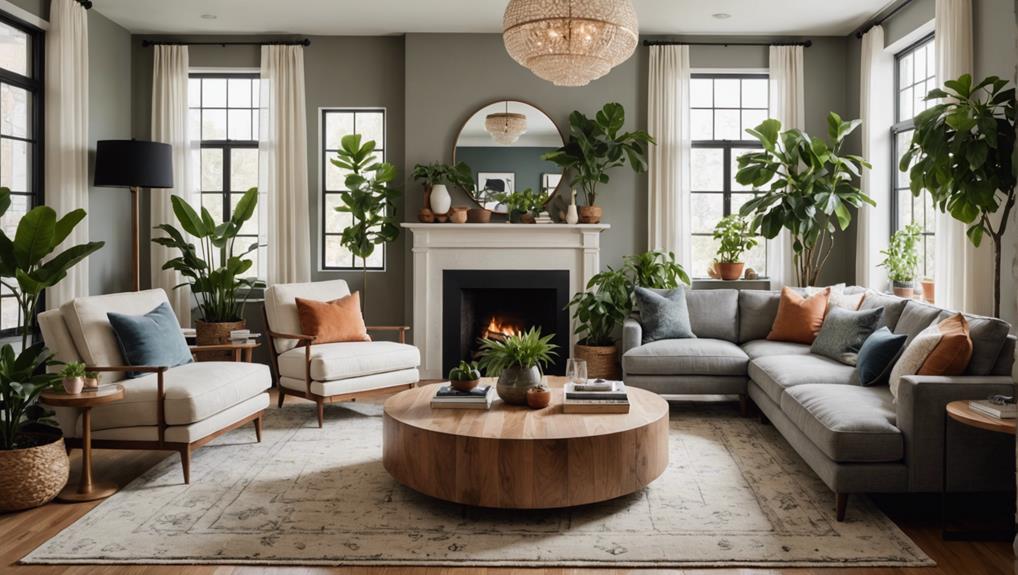
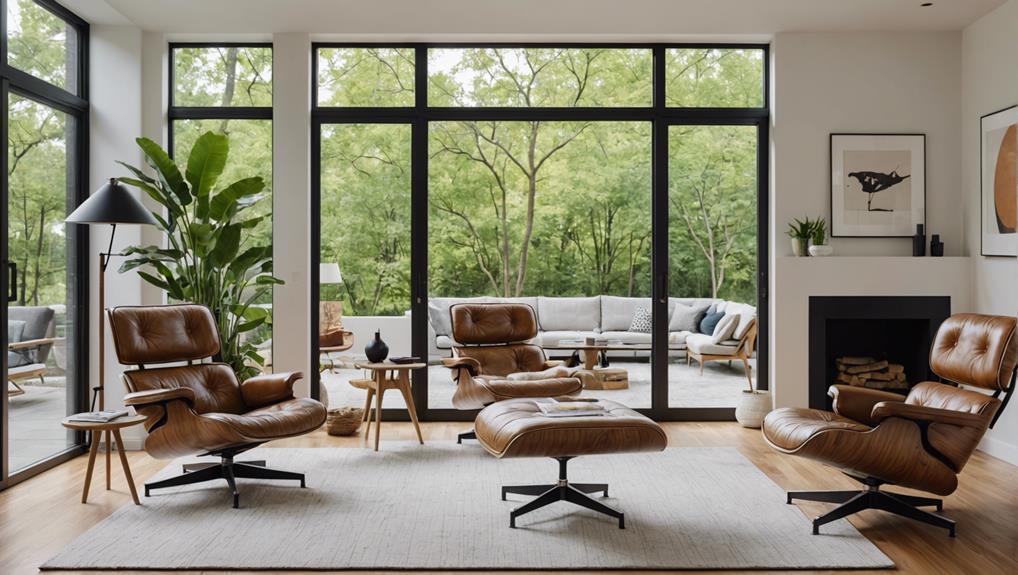
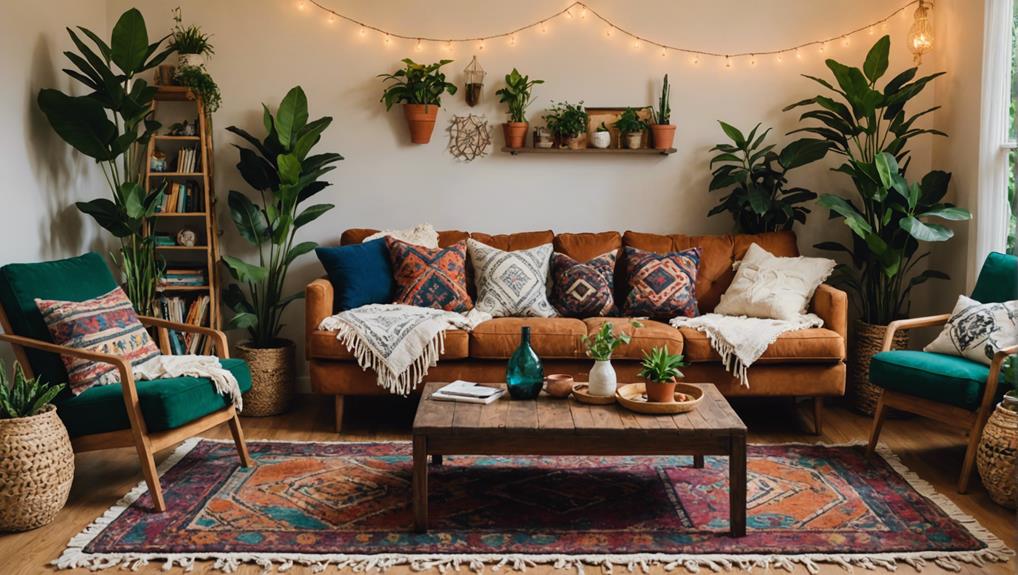
Leave a Reply